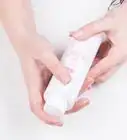This article was co-authored by Luca Buzas. Luca Buzas is makeup artist, wardrobe stylist and creative coordinator based in Los Angeles, California with over 10 years of experience. Luca focuses her work on photo shoots, films, commercials, and web content. She has worked with brands such as Champion, Gillette, Disney, and The North Face and with celebrities such as Magic Johnson, Julia Michaels, and Chris Hemsworth. She has a Bachelors in Wardrobe Styling from Mod'Art International Hungary.
There are 16 references cited in this article, which can be found at the bottom of the page.
wikiHow marks an article as reader-approved once it receives enough positive feedback. In this case, several readers have written to tell us that this article was helpful to them, earning it our reader-approved status.
This article has been viewed 389,837 times.
Having a “healthy glow” is a common goal. Even if your skin isn’t perfect, it’s possible to achieve a healthy glow using makeup. A healthful lifestyle and good skincare regimen will also go a long way in helping you achieve beautiful, glowing skin.
Steps
Choosing the Right Materials
-
1Know your skin. Exactly what you’ll need to achieve a healthy glow will depend on the quality of your skin:
- If your skin is already quite clear, you may prefer to use a BB cream or tinted moisturizer, which are lighter than a foundation.
- If you have heavy acne, you may want to opt for a dual concealer that contains both green and skin-tone hues, as green can help neutralize the red of your pimples; in addition, you’ll definitely want to use foundation.
-
2Pay attention to what you look like when you’re flushed. Knowing the natural colors of your skin when it’s flushed (i.e. red/pink) will help you choose which blushes and lip colors to use for a natural glow.
- To find out what you look like when you’re flushed, jump up and down or run around for a few minutes until you feel a bit out of breath; your cheeks and lips should look darker than normal. This is the color you want to aim for in your blush and lipstick.
Advertisement -
3Purchase a primer. A good primer will minimize fine lines and pores, and leave your skin feeling velvety smooth. It will also help your makeup stay put. [1]
- There are different types of primer, so choose one that matches your skin type -- for example, for oilier skin, you’ll want to use a gel primer.
- You can purchase a good primer at most stores that carry makeup. Aim for a store that carries a lot of makeup; that way you can experiment with different options to see which primer works best for you.
-
4Purchase a concealer. If you already have clear skin, you needn’t use a concealer. If you have any dark spots, under-eye circles, or pimples, a concealer can help you cover them up.
- Choose a concealer that matches your skin as closely as possible. It may take some experimentation on your own skin to find the concealer that’s right for you.
-
5Buy a good foundation. The ideal shade of foundation for you will be one that disappears into your skin.
- If you have young, healthy-looking skin, you can either skip the foundation all together, or try a tinted moisturizer or BB cream.
- Tinted moisturizers and BB creams are much lighter than foundations. These provide sheer coverage, giving you a more natural look.
- Look for foundation, BB creams, and/or tinted moisturizers with an SPF included.
-
6Buy a highlighting product. Highlighters come in liquids, creams, and powders, and are great for adding a little glow to your skin.
- Some makeup artists recommend avoiding highlighters with silvery or champagne tones, as these can make your skin look frosty — instead, seek golden tones.[2]
- If your skin is mature, avoid using powders as they will sink into and highlight any fine lines or enlarged pores. Liquid highlighters are a safer choice.[3]
-
7Get a bronzer. Choose a translucent bronzer that will give your skin a bit of a glow without looking unnatural. Avoid bronzers that are too sparkly or too matte.
- To choose the right shade for you, hold the bronzer up to your face as you look in a mirror. The bronzer should only be one or two shades darker than your skin tone.[4]
- Sun-kissed is the look you’re going for.
-
8Buy some brushes (optional). It’s possible to apply makeup with your fingers and any applicators that come with your makeup; however, proper makeup brushes can help you achieve more professional-looking results.
- Most drugstores and beauty supply shops will carry a variety of brushes and basic sets. These will vary greatly in price.
- A good-quality brush will have strong bristles that do not fall out. It will also have a strong ferrule, which connects the bristles to the brush handle.
- Key brushes for glowing skin: concealer, foundation, powder, blush, bronzer, and shadow.
Creating Glowing Skin
-
1Start with a freshly washed and moisturized face. After washing your face with a gentle cleanser and patting it dry, apply a moisturizer. The moisturizer will create a smooth base that will help your makeup stay on.
- Ensure that the moisturizer has had time to sink into your skin so that you’re not applying makeup over a wet base.
-
2Prime your skin (optional). Once your moisturizer dries, apply a very light layer of primer to your face. With your fingers, add a few dabs of primer to the centre of your face (nose, forehead, chin) and then work your way out.
- Be sure to allow the primer to dry for a few minutes before applying any makeup on top of it.[5]
-
3Apply a concealer to your problem areas (optional). Use a small brush to apply concealer over any dark circles or spots on your face. Dab the concealer with your ring finger to help blend it into your skin.
- If your skin is free of blemishes such as pimples or dark circles, you can skip this step.
-
4Apply foundation on to your skin. Foundation will help even out your skin’s tone and texture. Using a makeup sponge, dab some foundation on your nose and chin, then blend it outward.
- Some makeup artists suggest using only four dots of foundation and then blending them outwards with your hands or a brush. In this method, you would apply 1 dot in the centre of each: your forehead, your cheeks, and your chin.[6]
- For a more natural look, apply foundation everywhere but your forehead and cheeks.
- If your skin is already quite clear, you can use a BB cream or tinted moisturizer instead of a foundation.
-
5Apply a dusting of matte, translucent powder (optional). A matte powder will help set your foundation, giving you a good base for additional makeup. It will also help give your skin a velvety texture.[7]
-
6Apply a highlighting liquid, cream, or powder. A highlighter is key in giving your skin a glowy look. Apply it to the bridge of your nose, your cheekbones, the corners of your eyes, and in the dip of your upper lip.[8]
- You can also apply a bit of highlighter to the skin just below your eyebrows, and to the center of your chin.
- You can apply the highlighter using a foundation brush, or by dabbing it on to your skin with your ring finger.[9]
-
7Apply a sheer bronzing powder. Once you’re done applying everything else, finish it off with a sheer powder. This will help set your makeup and give you a little extra glow.
- Use a big brush to apply the powder, and go very very light on it. Apply it to your T-zone and outward.[10]
- Some makeup artists recommend using a pale yellow translucent powder so as to avoid looking pasty.
Highlighting Your Cheeks, Eyes, and Lips
-
1Apply blush. To give your skin a natural flushed look, you can apply blush on top of the translucent powder. Apply the blush to the apples of your cheeks, drawing the brush upwards towards your hairline.
- Two-blush method: Starting at the apples of your cheeks, pull the brush upward toward your hairline, then down slightly. Then, just on the apples of your cheeks, apply a lighter shade of the same color.
-
2Apply a creamy, neutral eyeshadow. Pinks, golds, and plums are great shades for highlighting your eyes and keeping them looking fairly natural.
- For a natural look, ensure that your eyeshadow doesn’t cake or clump in the lines of your eyes. Creamy eyeshadows may be a better choice than powdery ones.
- You can also dab some highlighter on your eyelids to give them an extra glow.
-
3Apply eyeliner. You can keep it pretty natural or very dramatic depending on which eyeliner you choose, and how you apply it.
- Natural: Apply a light, feathery line of eyeliner in a neutral shade (brown, soft black) to your lash line. You can smudge it afterward to make it look less intense.
- Dramatic eyes and a glowing face with neutral lips are a classic look. Draw a classic cat’s eye with black liquid liner, or do a gold smokey eye lined with a smudged black liner.
-
4Apply mascara to your eyelashes. Use a non-clumping formula in brown or black to keep your makeup looking natural.
- You may want to curl your eyelashes using an eyelash curler beforehand.
- If your eyelashes are already dark and you only want to help define them more, you can also use a clear mascara.
-
5Apply a balm or lipstick to your lips. Well-moisturized, soft lips will complement your dewy, glowing skin nicely. You may want to use only a lip balm.
- If you want to wear lipstick, stay within the natural shades of your skin (particularly when flushed) for a natural look.
- If you do decide to wear a more dramatic color (for example, reds or rich berry tones), go easy on the eye makeup, otherwise you may look overly made up.
Taking Care of Your Skin
-
1Wash your face each morning and night. Use a gentle cleanser that’s tailored to your skin type — for example, sensitive, combination, oily.
- If you don’t have acne, you can also exfoliate your face twice a week to help remove dead skin cells and brighten your skin.
- Avoid exfoliating your skin if you have acne, as the exfoliating beads can cause acne to spread.
-
2Apply a facial toner to your skin (optional). A toner will help balance your skin’s pH and remove anything the cleanser missed. Many dermatologists recommend applying a toner to your face after washing it.
- Avoid toners that contain alcohol, as these can dry out and irritate your skin.
-
3Apply a moisturizer to your face after washing. Use a moisturizer designed for your skin type: dry skin will require a richer moisturizer than oily skin, which benefits from light creams or gels.
- Seek a moisturizer that contains an SPF, which is important for protecting your skin from the sun’s harmful UV rays.
-
4Wear sunscreen. Wear a broad-spectrum sunscreen every day, regardless of whether it’s sunny or cloudy. Aim for an SPF 30, and reapply every 2 to 3 hours that you’re outdoors.[11]
-
5Tailor your products to the season. You might use an oil-free moisturizer in the hotter months when your skin is more likely to be oily, but in the winter, you may need something richer to combat indoor heating and cold weather, which can dry your skin.[12]
-
6Avoid using too many products. Using too many products on your skin can cause irritation. According to some dermatologists, the only products you need for beautiful skin are a simple cleanser, sunscreen, and moisturizer.[13]
- For mature skin (with fine lines and enlarged pores), add a retinoid or retinol to your skin care regimen.[14]
-
7Drink enough water. When you’re dehydrated, your skin can appear dull and fine lines may look deeper. To calculate how much water you need each day, divide your body weight (in pounds) in half, and drink that amount in ounces.[15]
- If you exercise or live somewhere hot (i.e. if you sweat a lot), you will need to drink more than half of your body’s weight in ounces.[16]
- A 150-pound woman would drink between 75 and 150 ounces of water each day, depending on her level of activity.
-
8Eat healthily. Aim for a diet rich in fruit and vegetables, lean proteins, healthy fats, and unprocessed foods. Keep your sugar intake low.[17]
-
9Get enough sleep. Getting enough sleep on a regular basis keeps the skin healthy by optimizing the secretion of human growth hormone (HGH). HGH promotes cell renewal and collagen production, which will help the skin look its best.[18]
- Adults need between 7 and 9 hours of sleep per night; teenagers need 8.5 to 9.5 hours of sleep per night.[19]
Expert Q&A
Did you know you can get expert answers for this article?
Unlock expert answers by supporting wikiHow
-
QuestionWhat products make your face glow?
 Luca BuzasLuca Buzas is makeup artist, wardrobe stylist and creative coordinator based in Los Angeles, California with over 10 years of experience. Luca focuses her work on photo shoots, films, commercials, and web content. She has worked with brands such as Champion, Gillette, Disney, and The North Face and with celebrities such as Magic Johnson, Julia Michaels, and Chris Hemsworth. She has a Bachelors in Wardrobe Styling from Mod'Art International Hungary.
Luca BuzasLuca Buzas is makeup artist, wardrobe stylist and creative coordinator based in Los Angeles, California with over 10 years of experience. Luca focuses her work on photo shoots, films, commercials, and web content. She has worked with brands such as Champion, Gillette, Disney, and The North Face and with celebrities such as Magic Johnson, Julia Michaels, and Chris Hemsworth. She has a Bachelors in Wardrobe Styling from Mod'Art International Hungary.
Makeup Artist & Wardrobe Stylist Add a nighttime cream to your daily skincare routine for the best results. Nighttime creams are often much stronger than what you might put on during the day. They work great for returning moisture, reducing redness, and taking care of problem spots, which make them essential for getting a fresh glow.
Add a nighttime cream to your daily skincare routine for the best results. Nighttime creams are often much stronger than what you might put on during the day. They work great for returning moisture, reducing redness, and taking care of problem spots, which make them essential for getting a fresh glow. -
QuestionWhich primer is the best for teenagers?
 Angel OnFireCommunity AnswerThe primer that's best for you totally depends on your skin. You might be allergic to some, you might prefer oily primers or non-oily primers, it totally depends on your skin.
Angel OnFireCommunity AnswerThe primer that's best for you totally depends on your skin. You might be allergic to some, you might prefer oily primers or non-oily primers, it totally depends on your skin. -
QuestionHow can I deal with dark circles around my eyes?
 Community AnswerUse cotton to apply lemon juice, aloe or witch hazel on the affected area.
Community AnswerUse cotton to apply lemon juice, aloe or witch hazel on the affected area.
Warnings
- If your skin feels hot or itchy after you apply makeup, this could be a sign of a reaction to something you’ve applied. To keep your skin looking healthy, avoid using anything that makes your skin feel hot or itchy.⧼thumbs_response⧽
- Makeup can cause acne. If you already have acne, or if you notice that you break out when you wear makeup, seek fragrance-free, non-comedogenic (pore-clogging) formulas (Almay is a popular brand).⧼thumbs_response⧽
- Seek a bronzer that does not contain bismuth oxychloride, as this can irritate your skin.[20]⧼thumbs_response⧽
References
- ↑ http://www.makeup.com/tutorial-how-to-apply-primer-like-a-pro
- ↑ http://www.elle.com/beauty/makeup-skin-care/tips/g8971/how-to-apply-highlighter/?slide=3
- ↑ http://www.elle.com/beauty/makeup-skin-care/tips/g8971/how-to-apply-highlighter/?slide=3
- ↑ http://www.cosmopolitan.com/style-beauty/beauty/advice/g1416/how-to-use-bronzer/?slide=1
- ↑ http://www.makeup.com/tutorial-how-to-apply-primer-like-a-pro
- ↑ http://www.harpersbazaar.com/beauty/skin-care/advice/g2815/chanel-glowing-skin/?slide=2
- ↑ http://www.harpersbazaar.com/beauty/skin-care/advice/g2815/chanel-glowing-skin/?slide=3
- ↑ http://www.elle.com/beauty/makeup-skin-care/tips/g8971/how-to-apply-highlighter/?slide=4
- ↑ http://www.elle.com/beauty/makeup-skin-care/tips/g8971/how-to-apply-highlighter/?slide=4
- ↑ http://www.harpersbazaar.com/beauty/skin-care/advice/g2815/chanel-glowing-skin/?slide=5
- ↑ http://www.webmd.com/beauty/face/tips-for-gorgeous-skin?page=1
- ↑ http://www.webmd.com/beauty/face/tips-for-gorgeous-skin?page=3
- ↑ http://www.webmd.com/beauty/face/tips-for-gorgeous-skin?page=2
- ↑ http://www.webmd.com/beauty/face/tips-for-gorgeous-skin?page=2
- ↑ http://www.webmd.com/diet/water-for-weight-loss-diet?page=2
- ↑ http://www.webmd.com/diet/water-for-weight-loss-diet?page=2
- ↑ http://www.webmd.com/women/guide/nutrition-101-how-to-eat-healthy
- ↑ http://www.webmd.com/beauty/face/tips-for-gorgeous-skin?page=3
- ↑ http://www.webmd.com/sleep-disorders/guide/sleep-requirements
- ↑ http://www.webmd.com/beauty/makeup/the-lowdown-on-mineral-makeup?page=3
- Videos provided by BlissfulBrii
About This Article
To give your face a creamy glow, you’ll need primer, foundation that matches your skin tone, highlighter, and a bronzer. Before you apply any makeup, wash and moisturize your face to protect your skin. Once your moisturizer has soaked in, apply a thin layer of primer to help your makeup last longer and even out your skin tone. If you have any spots or blemishes, cover them with a little concealer. Then, blend your foundation into your face with a brush or sponge. After that, apply your highlighter to the bridge of your nose, your cheekbones, the corners of your eyes, and in the dip of your upper lip, which helps give your skin a glowing look. Finally, apply a bronzing powder to your whole face to help set your makeup and give you a little extra shine. For more tips from our Beauty co-author, including how to highlight your cheeks, eyes, and lips with makeup, read on!
-Step-1-Version-5.webp)
-Step-2-Version-4.webp)
-Step-3-Version-5.webp)
-Step-4-Version-5.webp)
-Step-5-Version-4.webp)
-Step-6-Version-5.webp)
-Step-7-Version-5.webp)
-Step-8-Version-5.webp)
-Step-9.webp)
-Step-21.webp)
-Step-24-Version-3.webp)
-Step-25-Version-3.webp)
-Step-26-Version-3.webp)
-Step-27-Version-3.webp)
-Step-28-Version-3.webp)
-Step-29-Version-3.webp)



























































